NOTE: To find out more about anything I’ve mentioned below, please click on the blue highlighted words to go to their websites.
On the flight from Johannesburg to Durban I struck up a conversation with the fellow sitting next to me. Turns out he is the Account Manager for Product Managers of DyStar – of which Procion Dyes is a subsidiary! Of all people to sit beside, the guy who supplies dyes to the quilt artists, shops and fabric manufacturers in Africa! This is where the dyes for the shweshwe fabrics we are about to buy come from.
Durban is quite different from Johannesburg – it is on the coast of the Indian Ocean, for one, and further south. The ocean is quite warm at this point, and the air is quite a bit more humid. It feels sub-tropical and there are lots of tropical/textural gardens like I’ve seen in parts of Australia.
We drive directly to the home of Odette Tolksdorf, who is Val’s partner in this venture. She has been doing the local organizing of this trip – brilliantly, in my opinion. Odette has provided a beautiful lunch for all of us, plus our first encounter with three other South African art quilters.

Odette with one of her pieces.

Ann had made a number of small sewing kits which she gave to the Isipethu Embroidery Group (along with our embroidery threads) via Dudu, who came to the lunch. We gave her a bunch of embroidery threads as well to take back to the group.

I fell in love with Jeanette’s work. Judy, the coordinator of Isipethu, is sitting behind.
It was a very convivial afternoon. We stopped at the Artisan Gallery on the way to our hotel. More stuff to buy!!! (By now it seemed impossible for the lot of us to NOT buy, when given the opportunity!)
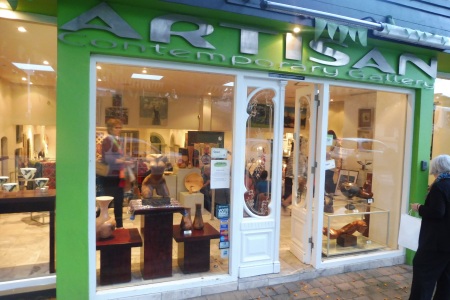
Our hotel in Durban did not feel as pretentious as the one in Johannesburg, nor as barricaded. Yes, there’s still a sense of security everywhere, but we were able to walk along the road to local restaurants without feeling on guard to the same extent. We were beginning to be able to see more open walls and gates to the houses beyond.
The next day was nice and warm and a bit rainy, but it didn’t prevent us from dipping our toes in the Indian Ocean!

We were headed for our first chance to refill our bags with fabric, after unloading some of the supplies we brought with us. We went to the fabric area of Durban, to Val’s favourite shop for shweshwe fabric! This is originally a blue denim-like cotton fabric, painted with geometric designs, but now it’s all the colours of the rainbow. The fabric in the shop feels like cardboard, with all the sizing in it, but it washes out to be a thick-ish (like denim) cotton and much softer. The designs are beautiful. It was so difficult to choose! It was NOT the budgetted 1/2 hour stop!!! Kudos to our driver for getting the bus around the narrow streets, too.

The fabric sector of Durban.

A very colourful corner of the shop.
There was lots going on in the street outside as well.


We visited the Indian and African Market in Durban, meeting an old friend of Val’s from when she lived here. Spices were purchased! And this is where I bought the first of my bowls made from telephone wire.
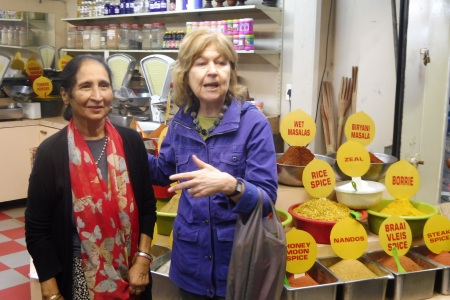

The Durban Botanical Gardens features some of my favourite things: cycads, for one. Have you ever read the book “Island of the Color Blind” by Oliver Sacks? Fascinating tale of an island in the South Pacific where they eat flour made from the fruit of the cycad. It results in the whole island being unable to see colour! The fruit itself is very colourful, though.
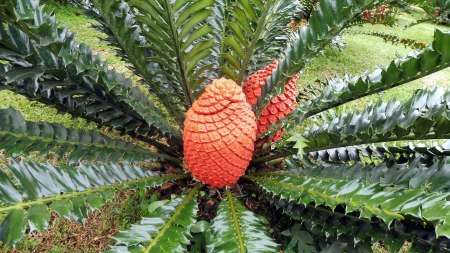

We also saw for the first time, the Bird of Paradise variety called “Mandela’s Gold”.
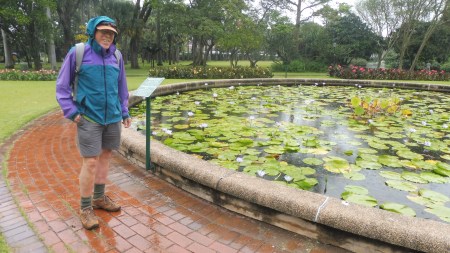
It kept raining off and on all day.
After lunch we visited the Phansi Museum and had a brilliant guided tour through all the artifacts there. This is a private museum, started as a collection in the basement of Architects and Planners offices. There is so much Zulu art here! Our guide, Phumizile Nkosi, was very entertaining, especially when describing some of the strange ways of using things. I had to take a picture of some of their musical instruments.

Guitars made from oil cans.
They had a temporary exhibit of Mandela-inspired beaded art while we were there.
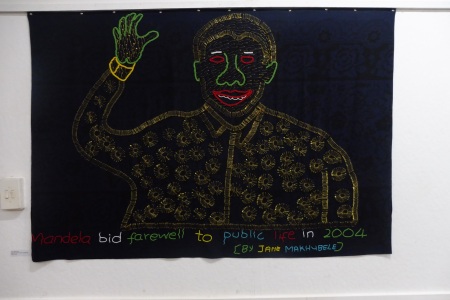
Our day finished with a lovely Indian meal featuring the famous Durban curry at Palki’s
The next day was all about ceramics, sculpture and beading. We set out for Ardmore Ceramic Art in the KwaZulu-Natal Midlands. If you have the time, click on the Ardmore name and visit their website to see some of their magnificent works.
Started by Fee Halstead in 1985, the studio employs local Zulu artisans who have trained there, making fanciful African-inspired ceramics that are exhibited and sold around the world. Over the years, AIDS has taken many of their artists, and so they now provide anti-retrovirals to their people. So many of the stories around these projects we visit have AIDS stories wound around them. Health care as well as mental care entwine to create these hopeful, successful projects.

A wall of plates dedicated to the artists whom they have lost to AIDS.
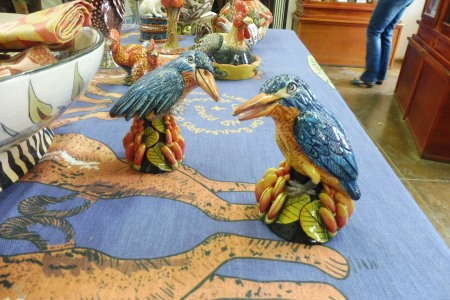

Most of the potters are men; the women are the painters.
Fee is also an equestrian; her daughter is a member of the South African Olympics equestrian team, and we were privileged to watch them working a couple of their horses.

We stopped briefly at an extraordinary monument/sculpture to commemorate the place where Nelson Mandela was captured before he went to Robben Island. These are individual vertical steel bars that look like nothing much until you stand exactly THERE.

I am amazed at the creative process it takes to come up with this idea!
Our next stop was the Hillcrest AIDS Centre, where we learned about their vital work with AIDS patients, including a 24 bed respite care facility, and dropped off supplies to help them continue their work. Happily, 70% of people who stay in the care facility go home, thanks to the excellent drugs now available for AIDS patients. Our suitcases were getting pretty empty by this point, and their little shop beckoned, filled with exquisite beaded things we could carry home.


You could help support this too, by shopping in their Woza Moya craft shop.
Onward! To meet Carl Roberts, Sculptor, at his home. Tucked away in the jungle treetops, his studio is filled with unusual things – he works with wood, bone and stone, and it makes for a fascinating “stash” as a result. He and his wife were so generous in allowing us to visit them at home, and the work was astonishing and magical.
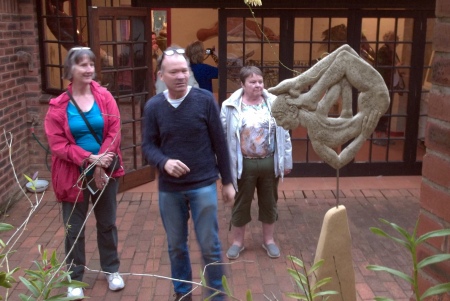
What a jam-packed visit to the Durban area! We said farewell to our wonderful, informative and fun guide Jacqui the next morning, and flew down to East London to continue the trip.
Leave a comment